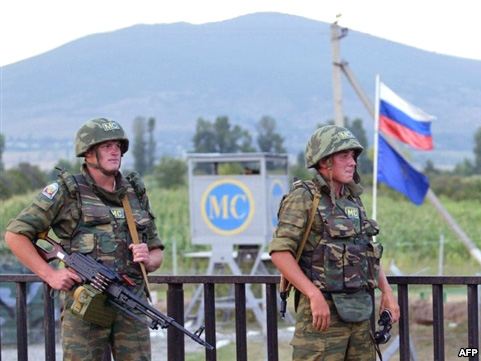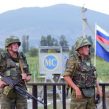
Warsaw Pact, CIS Peacekeeping, CSTO Operations: Moscow Develops “Collective” Intervention Concept (Part Two)
Publication: Eurasia Daily Monitor Volume: 8 Issue: 170
By:

Emboldened by international tolerance of its seizure of Moldovan territory in 1992 (see Part One in EDM, September 15), but still unable to muster support on the state level within the CIS, Russia experimented with “collective” peacekeeping at the sub-state level against Georgia in South Ossetia. It forced an isolated Georgia in 1992 to accept a format that included North Ossetia (Russia’s administrative unit) and South Ossetia (under Russian-controlled authorities, inside Georgia’s territory), in a format alongside state actors Russia and Georgia, with the OSCE in an observer’s and facilitator’s role. This format involved a Joint Control Commission and Joint Peacekeeping Forces under Russian command.
Those arrangements gave Russia four voices (including its veto power in the OSCE) against Georgia’s single voice; allowed Russia discretionary freedom of action in the territory seized from Georgia; and, in the absence of any further international involvement, led inexorably to fully-fledged Russian occupation in 2008.
In 1994, Russia elicited “collective” authorization by the Commonwealth of Independent States (CIS, comprised of 12 countries) for Russian “peacekeeping” within Georgia in Abkhazia. From that point onward, this purely Russian operation went under the name of a CIS operation. Although the CIS never held mandate-granting authority under international law (the CIS itself lacks standing in international law to this day), the CIS Council of heads of state purported to grant a “mandate” for this Russian operation and prolonged it routinely on an annual basis. From 2003 onward, that annual routine was replaced with an open-ended prolongation. Year after year, Russia asked other CIS countries to contribute at least symbolically with troops and financing to this operation, but they all declined. They went along passively with Russian “peacekeeping” in Abkhazia because a prostrate Georgia had agreed in the first place; since international indifference precluded other options; and due to Russia meeting a crucial concern of CIS countries by pledging to respect Georgia’s territorial integrity. That pledge remained on paper until 2007 and was abrogated outright by Moscow in 2008.
The UN Security Council provided its own cover of multilateralism on Russia’s “peacekeeping” in Abkhazia. It not only endorsed that operation, but praised it in annual resolutions, with the United States passively concurring. This bought Russian acceptance of a symbolic UN presence in the field in Abkhazia (UNOMIG). However, Russia summarily evicted that presence in 2008, along with the OSCE’s symbolic presence in South Ossetia, when Moscow deemed that international cover to have outlived its usefulness. The transition period, from internationally-endorsed Russian intervention to unrecognized occupation, had run its course.
Azerbaijan successfully avoided Russian involvement in peacekeeping on Azerbaijan’s territory after the 1994 Karabakh ceasefire. Baku ruled out that proposal at the OSCE’s 1994 summit and remains opposed to it. Azerbaijan adheres to the principle that Minsk Group co-chairing countries and countries contiguous to the conflict theater are not eligible to participate in international peacekeeping missions in this theater. Russia is thus ineligible on both counts.
In 1993, the CIS Council of Heads of State authorized a Russian peacekeeping mission in Tajikistan’s civil war. Russia’s 201st Motor-Rifle Division, which had fought in Afghanistan since the Christmas 1979 invasion of that country, withdrew to Soviet Tajikistan in 1989, and turned “peacekeeper” four years later under the CIS mandate. As in the case of Abkhazia, the CIS acted without holding any mandate-granting authority in international law. Again as in Abkhazia, the UN accepted this pretense, fielding a symbolic mission of observers (UNMOT) alongside Russian troops in Tajikistan.
This became the first Russia-led collective operation with real, if token, participation by other CIS countries. Kazakhstan, Kyrgyzstan, and Uzbekistan each provided company-sized units to this mission, alongside the 11,000-strong (at that time) 201st Division.
Following the end of Tajikistan’s civil war in 1997, Russia downsized that division to some 5,000 (still the largest Russian ground-troop contingent in a foreign country) and declared the end of that “peacekeeping” operation in 1999. With the CIS out of the picture, Russia and Tajikistan signed a bilateral agreement in 1999, ratified only in 2004, on basing rights for those Russian troops at Dushanbe and other locations in the country. Under another bilateral agreement in 2005, Russia transferred to Tajikistan the responsibility for protecting the Tajikistan-Afghanistan border troops took over from Russia (see EDM, January 22, 1996; February 15, 1999; October 6, 19, 2004; February 21, 2006; November 18, 2008).
On an official visit to Tajikistan in September 2011, Russian President Dmitry Medvedev called for prolonging the military basing rights by a further 49 years (the same time-frame as the extensions wrought by Medvedev from Ukraine and Armenia). Russia wants that extension signed by spring 2012 (Hovar, September 2; Interfax, September 2, 9).
Russia created the Collective Security Treaty Organization (CSTO) in 2002, with follow-up agreements establishing three groups of forces: Russia-Belarus, Russia-Armenia, and the Central Asia group of forces comprised of Russia, Kazakhstan, Kyrgyzstan, Tajikistan, and Uzbekistan. The first two groupings exist in a purely nominal sense (only the bilateral treaties, Russia-Belarus and Russia-Armenia, operate in practice, outside CSTO’s framework). The Central Asia group includes two Russian battalions from the 201st division in Tajikistan, the Russian air base at Kant in Kyrgyzstan, and one battalion from each of the four Central Asian member countries. These battalions are permanently home-based, except for periodical joint exercises.
In 2010, Russia announced ambitious plans to create Collective Rapid Reaction Forces of up to 20,000 troops, nominally under the CSTO but subordinated to Russia in practice. Moscow proposes to deploy such troops if necessary in Russian-led stability operations, primarily within CSTO member countries (see EDM, September 8, 9, 14, 15). Apparently, Moscow aims to elicit Western recognition or at least silent tolerance of a Russian sphere of military dominance, as has already occurred with Russia’s de facto monopoly on “peacekeeping” and conflict-resolution in its former Soviet domain, under some form of “collective” cover.




